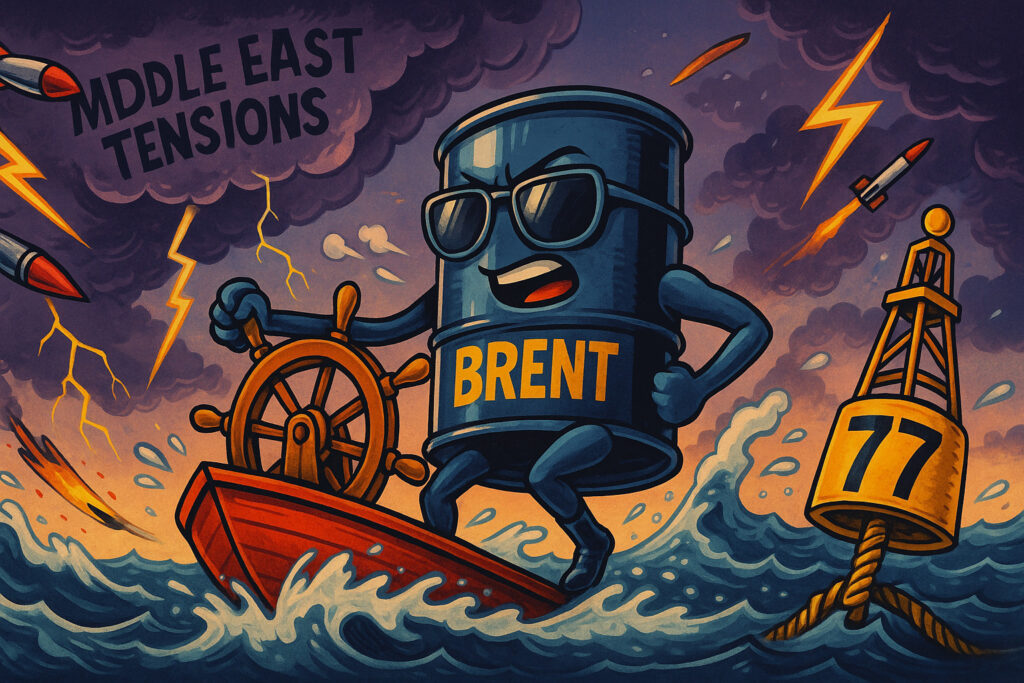Introduction
Crude oil prices surged on July 16, 2025, with Brent crude rising to $77.03 per barrel—its highest level since April—amid escalating geopolitical tensions in the Middle East and renewed concerns over global supply disruptions. West Texas Intermediate (WTI) also jumped 3.1% to $73.11 per barrel, marking one of the strongest daily rallies this quarter.
The catalyst was a fresh wave of military clashes near critical oil infrastructure in the Persian Gulf, including drone strikes and naval blockades affecting shipping lanes used for roughly one-fifth of global oil trade. The rally was further supported by tighter inventories in the U.S., as revealed in recent API estimates, and resilient global demand signals from the U.S. and India.
This article analyzes the causes and market response to the oil rally, evaluates its impact on related asset classes, and assesses the broader macroeconomic and policy implications.
Geopolitical Flashpoints Return
Multiple reports confirmed increased military activity near the Strait of Hormuz, where drone strikes hit petroleum loading docks at a major port in southern Iran. Western naval patrols were also heightened amid rising tensions between regional powers. Analysts from energy consultancy Platts noted that “any prolonged disruption through the Strait could remove up to 15 million barrels per day of potential supply.”
While the damage so far appears limited, the threat to physical flows caused traders to price in a renewed geopolitical premium, particularly for Brent, which is more exposed to international supply risks.
Inventory and Demand Trends Reinforce Rally
The rally was not purely speculative. According to the American Petroleum Institute (API), U.S. crude inventories fell by 5.2 million barrels last week, exceeding estimates of a 2.8 million barrel draw.
Meanwhile, gasoline demand has remained robust, with U.S. product supplied averaging over 9.3 million barrels per day in recent weeks. India, the world’s third-largest oil consumer, reported June crude imports up 6.7% year-over-year.
OPEC+ production discipline and seasonal refinery demand in Asia are also contributing to a tighter physical market.
Market Response: Energy Stocks and Commodities Surge
Energy equities led global markets:
- S&P 500 Energy Sector: +3.4%
- ExxonMobil (XOM): +3.9%
- Chevron (CVX): +3.7%
- ConocoPhillips (COP): +4.2%
Oilfield services and midstream firms posted outsized gains as well:
- Halliburton (HAL): +4.6%
- Schlumberger (SLB): +4.4%
- Kinder Morgan (KMI): +2.9%
The broader commodities complex was buoyant:
- Natural Gas (U.S.): +2.1% to $2.61/MMBtu
- Copper: +0.5% to $4.44/lb
- Gold: +1.0% to $2,558/oz, as investors hedged geopolitical risks
Fixed Income and FX Markets React
Bond yields rose modestly amid risk-on sentiment and rising inflation hedges:
- 10-year U.S. Treasury yield: +4 bps to 4.30%
- 2-year yield: +2 bps to 4.47%
In currency markets:
- U.S. Dollar Index (DXY): Flat at 104.38
- Canadian dollar (CAD): +0.4% to 1.3480 per USD
- Norwegian krone (NOK): +0.6% to 10.62 per EUR
Petro-linked currencies and emerging market FX performed well as oil prices rallied.
Inflation and Policy Implications
The oil rally could complicate central bank policy paths, particularly in economies still battling elevated core inflation. The Federal Reserve and European Central Bank have both signaled dovish intentions, but sustained energy cost increases may delay easing if inflation expectations rise.
Economists estimate that a sustained $5–$10/barrel increase in Brent could add 0.2–0.4 percentage points to headline inflation in major economies over the next three months.
However, the Fed is expected to focus more on core inflation and labor data. Fed Chair Jerome Powell recently stated that “temporary energy volatility will not drive medium-term policy decisions.”
Outlook for Oil Prices
Analysts are split on how far the rally can go. Technical resistance is seen at $78.50, with support near $73.30.
Bullish catalysts:
- Further Middle East escalation
- Continued U.S. inventory draws
- Strong summer demand in Asia
Bearish risks:
- Diplomatic de-escalation or ceasefire
- Surprise OPEC+ production ramp-up
- Weaker-than-expected China demand
Hedge funds added long positions in oil futures this week, according to CFTC data, suggesting growing conviction in higher prices.
Conclusion
Oil markets surged on July 16 amid a confluence of geopolitical risk, tightening inventories, and solid demand signals. Brent’s climb to $77 per barrel marked a key technical and psychological milestone, with markets quickly pricing in renewed supply concerns.
Energy stocks rallied in response, alongside safe-haven flows into gold and commodity-linked currencies. While broader financial markets showed resilience, the rally adds complexity to inflation dynamics and monetary policy expectations heading into the second half of 2025.
Looking ahead, investors will monitor:
- Developments in the Middle East for signs of escalation or diplomacy
- Official EIA inventory data (July 17) to confirm supply tightness
- Central bank commentary on inflation risks from energy markets
As geopolitical uncertainty rises and crude supplies tighten, oil may reassert itself as a pivotal macro force in the second half of the year—impacting everything from central bank policy to global risk sentiment.
